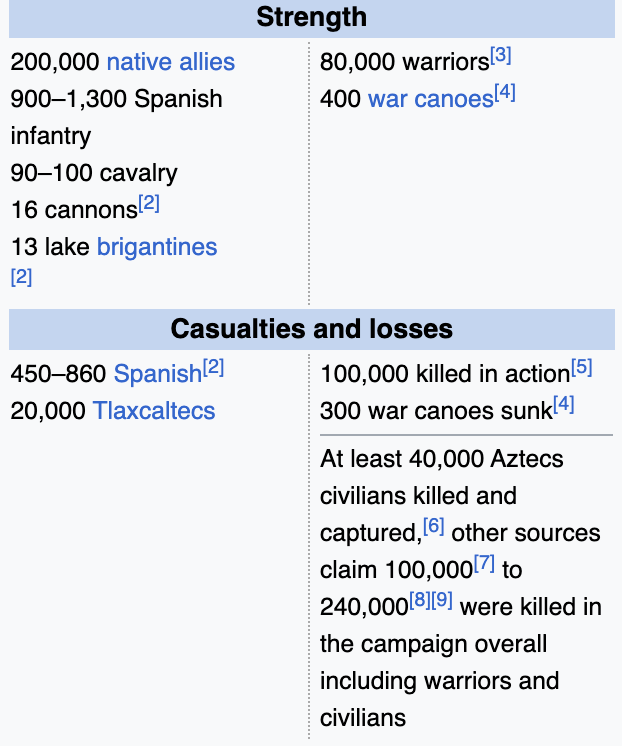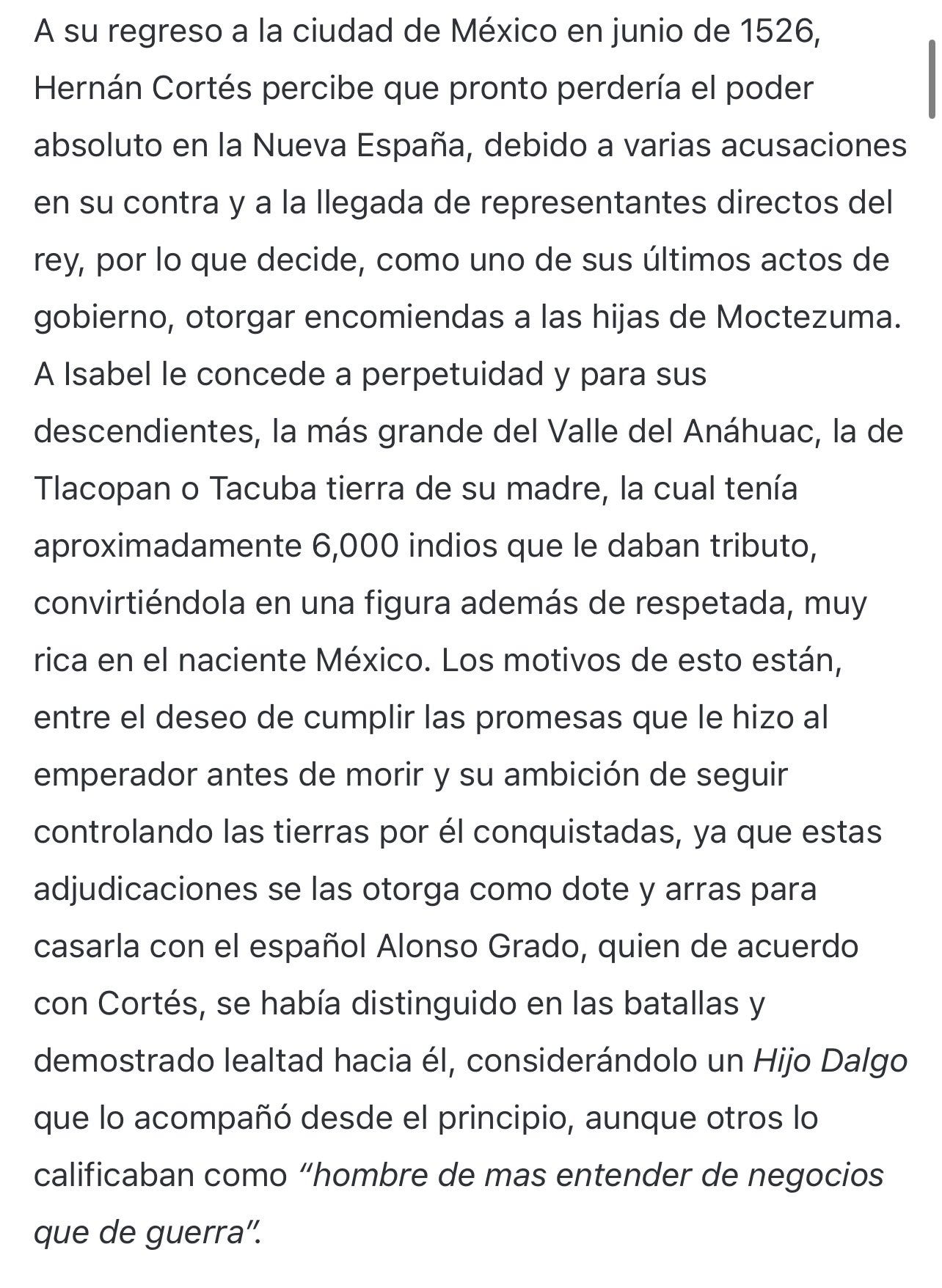The Aztec Empire's Demise: The Clash Between Mexica (Aztecs) and Tlaxcalans
The Tlaxcalan's should be given credit. The Spanish were simply helpers
It's likely that at some point in school, you were taught that the Spanish showed up in Mexico with significant guns, germs, and steel and singlehandedly took down the Aztec Empire. This makes for a compelling narrative of the conquest of America, and rarely does anyone question it. In Latin America, this story is used to hype up the Spanish as the absolute evil in the region. Unfortunately, schooling often leaves out many key details and backstories.
I originally wrote this as a Viral Tweet with over 1.5 million views. I’m finally clarifying what I said and organizing all the data into a post.
https://twitter.com/BowTiedPassport/status/164765049607174554
My original quote
”The fall of the Aztec Empire was really just a conflict between the indigenous Mexica(Aztecs) and the Tlaxcalans who had already been at war for decades.
The Spaniards simply tipped the war in Tlaxcalans favor.”
First of all, who are the Tlaxcalans? The Tlaxcalans were an indigenous people who inhabited the region and the state of Tlaxcala, Mexico. Tlaxcala is also the smallest state in Mexico. Its mainstream history is essentially nonexistent. There are even jokes that the state doesn't exist. People make these jokes both because it's so small and partly because there has been a lot of negative history towards Tlaxcalans for being "traitors" to Mexico by joining forces with the Spanish to stop the Aztecs.
1. Strength and Society:
- The Tlaxcalans were an independent civilization with a strong military tradition. They were known for their skilled warriors and had a well-organized society with a central government led by a council of elders and nobles. In fact, Tlaxcala was one of the few regions in Mesoamerica that had never been fully conquered by the Aztecs. They regularly engaged in wars to defend themselves from the Aztecs.
2. Conflict with the Aztecs:
- The Tlaxcalans and the Aztecs had a longstanding rivalry that dated back over 100 years before the arrival of the Spanish conquistadors.
- The Tlaxcalans detested the expansionist ambitions of the Aztecs, who sought to conquer neighboring regions, including Tlaxcala. Once the Aztecs conquered a new region and its people, they would impose heavy taxes on the residents.
- Not only were these taxes in the form of food and gold, but the Aztecs often demanded payments in blood – human sacrifices. The Tlaxcalans were never interested in allowing their people to be sacrifices for some other leaders.
- The Tlaxcalans also had their own matters of prestige and honor. They viewed themselves as equals to the Aztecs rather than as subordinates.
Alliance with the Spanish:
- When Hernán Cortés and his Spanish conquistadors arrived in the region in 1519, they spent around two years traveling from Veracruz, Mexico, into the interior on their search for gold.
They met the Totonac people of Veracruz, the Otomi of Central Mexico, along with many others.
With nearly every battle, a conclusion was reached: why label these people as enemies when the real adversary was the Aztecs? In fact, on some occasions, the Spanish could have been wiped out if it weren't for these alliances.
In the end, the Tlaxcalans and other indigenous groups saw the Spanish as an opportunity to weaken or even destroy their longstanding enemies.
Regarding Tenochtitlan and its fall, what history often overlooks is that the Spanish played a relatively minor military role in the Aztec Empire's downfall. While some may label this as "historical revision," it stands as historical fact.
The Spanish arrived by boat, and Hernán Cortés did not lead a massive Spanish Armada. He arrived with only a few hundred men. This information is available in both English and Spanish sources (I often consult Spanish documents for more specific details). The Spanish forces numbered anywhere from 600 to 3,000 soldiers, while the Tlaxcalans contributed a formidable force of 80,000 Tlaxcalans and over 100,000 other native allies. The Tlaxcalans not only provided the majority of the military power but also played a crucial role in logistics and support.
An argument often raised is the significant role played by Spanish weaponry in their conquest. However, it's important to note that Spanish firearms still relied on gunpowder, which posed several challenges.
Firstly, gunpowder was not in unlimited supply, making it a logistical concern. Secondly, the jungle warfare conditions in certain parts of Mexico, characterized by continuous rain throughout the year, rendered much of the gunpowder nearly useless. Wet gunpowder would fail to ignite or misfire, significantly diminishing the effectiveness of firearms.
In addition to the gunpowder issue, Spanish armor presented its own set of challenges. Spanish armor was made of metal, which was not only hot but also heavy and cumbersome. In contrast, the armor worn by native and Tlaxcalan warriors was soft, light, and woven, providing them with greater mobility in battle.
These factors highlight the importance of understanding the limitations and contextual challenges that the Spanish faced during their conquest of the Aztec Empire. While Spanish weaponry and armor had their advantages, they were not without vulnerabilities, and the environment and logistics played crucial roles in the outcome of battles and the overall conquest.
Ichcahuipilli - Spanish Link Indeed, it's worth noting that only a relatively small percentage of the Spanish forces wore metal armor, estimated to be around 10%. This metal armor, while offering protection against certain attacks, was not impervious. Arrows and other projectiles could still penetrate it.
As a result, many Spanish soldiers eventually opted to trade in their metal armor for Tlaxcalan armor, which had its advantages in the context of the campaign. Tlaxcalan armor was lightweight, woven, and offered better mobility. In the sweltering and challenging conditions of the Mesoamerican environment, this shift allowed Spanish soldiers to avoid heat exhaustion and maintain their agility in battle.
Cortés also had no military experience of his own, and his men were fresh soldiers, many of them without any combat experience. Natives had been fighting for decades, and in some cases (such as the Flower Wars), their battles were preplanned purely with the intent to train soldiers through combat experience. Cortés was ill-prepared to take on a city of millions.
Why did the Tlaxcalans not take over Mexico instead of the Spanish? The Tlaxcalans were not as expansionist as the Aztecs. They enjoyed the benefits of their empire, but we also forget that many groups in Mexico didn't even like each other. They didn't want to integrate every other group on the continent into theirs. They helped the Spanish on many occasions, fighting other groups as far south as Guatemala and even as far as the Philippines. However, their desire for governance was not their primary goal. Moreover, they were generously rewarded for their actions. Tlaxcalans did not pay taxes to the Spanish, retained their noble titles, and their land eventually became a state of its own, now known as...The Free and Sovereign State of Tlaxcala.
During that era, the Tlaxcalans were portrayed as heroes. They played a crucial role in the downfall of the Aztecs, putting an end to the practice of human sacrifices and benefiting many of the groups that allied with them.
What often gets omitted from historical accounts is that even after their conquest, the Aztecs attempted to subjugate the local populations. While the typical narrative may portray the Spanish as the most brutal dictators in the land, it's important to note that after the Spanish arrived and implemented reforms like outlawing slavery and other barbaric practices, some Aztec nobles who were allowed to retain their titles viewed the Spanish as being too lenient.
Example, the daughter of Moctezuma, the Aztec ruler, was granted one of the largest plots of land in the Mexican Valley. She maintained control over 6,000 slaves until her death and had the authority to govern as she pleased, including continueing practices like cutting the limbs from slaves and executing them for disobedience.
Doña Isabel Moctezuma, Tecuichpotzin (1509-1551)
Over time, as Mexico developed its modern mythology and a sense of resentment toward the Spanish conquest and colonial era, the Tlaxcalans, who had played a crucial role in that historical period, began to be portrayed in a negative light.
Recognize that history is multifaceted, and individuals and groups often have complex motivations and actions that can be interpreted differently through various lenses. While the Tlaxcalans initially aligned with the Spanish for their own reasons, it's crucial to consider the broader historical, political, and social factors that influenced their decisions.
Don’t call us traitors: descendants of Cortés’s allies defend role in toppling Aztec empire
At the end of the day, I am not here to portray the Spanish or Cortés as benevolent or even good figures. I am simply providing additional context to the story and teaching about a specific aspect of history, the Tlaxcalans. If I am to be called a revisionist, let my quote be: 'With a little help from the Spanish, the Tlaxcalans were able to liberate themselves from the oppressors' grip.
If you enjoyed the above - Check out these articles below
Guide To Mexico City
Mexico City is the largest city in North America and the capital of Mexico. It has more land than Los Angeles and more people than New York City. The amount of things to do in this city is unmatched. Although people from other parts of Mexico may think that Mexico City residents, known as Chilangos, are fast-paced and rude, compared to America, the pace…
I also recently wrote an article on the paid side of my substack, adding more context to the story. The Spanish arrived in Mexico with very few men, no knowledge of the land, and no knowledge of the local languages. The locals they encountered along the way are not acknowledged enough in the narrative."
The Conquest of Mexico & The Translators That Made It Possible
The conquest of Mexico was of course, a pivotal chapter in human history, where the fusion of military prowess, cultural exchanges, and linguistic intricacies shaped the destiny of civilizations. Beyond the narratives of guns, germs and steel, the role of languages might be the most critical aspect of all. Most of history severely leaves out that, none of the groups of people indigenous to Mexico…Spoke Spanish at the time of the Spanish arrival, and none of the Spanish broke any of the 68 languages alive at the time.
↓Don’t forget to hit the like/heart button. It helps with substack rankings↓













